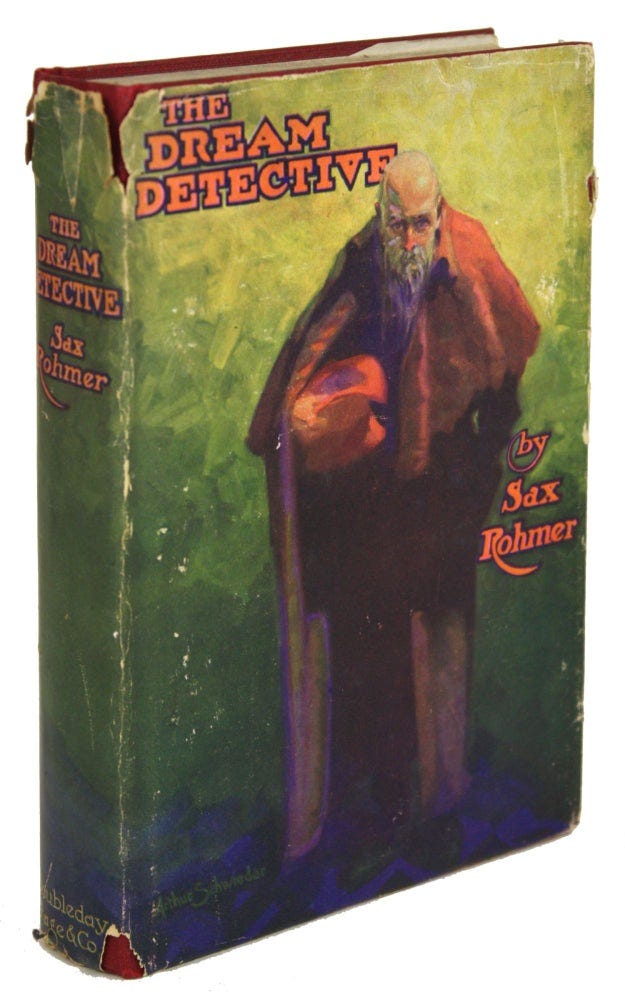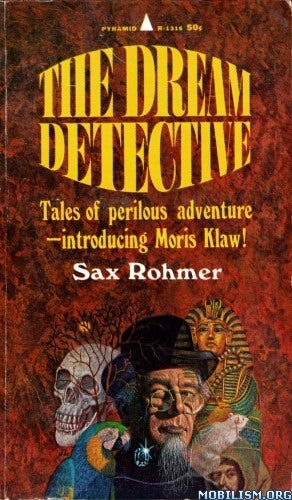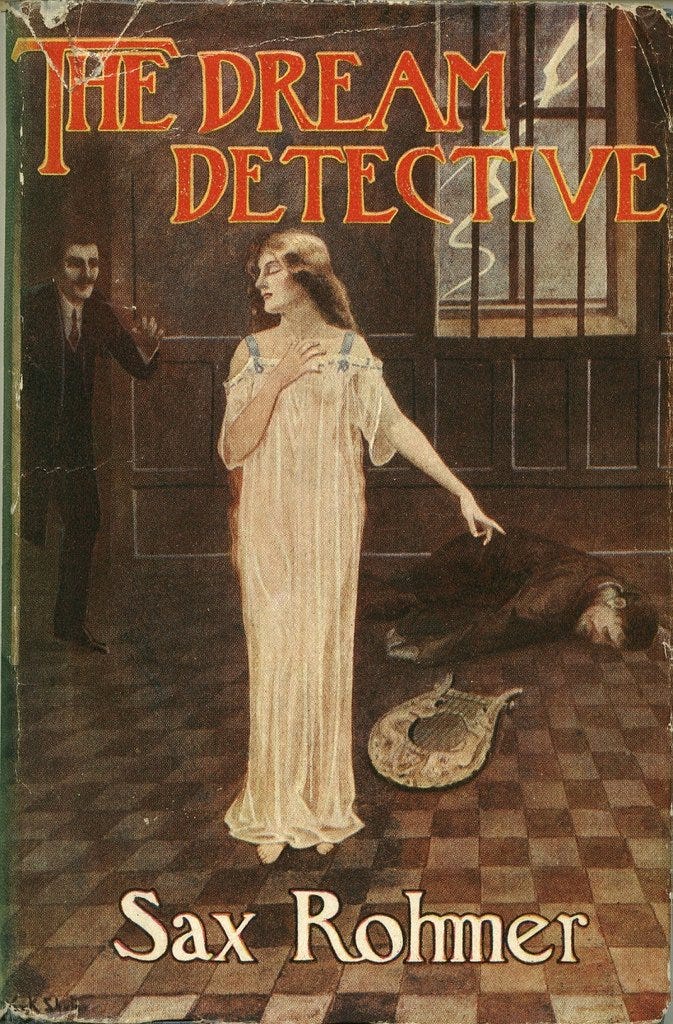The Dream Detective, Being Some Account of the Methods of Moris Klaw (1925) by Sax Rohmer
"Indeed the whole scene had delighted Rembrandt.”
Readers unfamiliar with The Dream Detective may wish to read my notes only after reading the collection.
“Good-morning, Mr. Searles,” she greeted me. “Is it not dreadful about poor Conway!” — and then glanced at Coram. I saw that she held a card in her hand. “Father, there is such a singular old man asking to see you.”
She handed the card to Coram, who in turn passed it to me. It was that of Douglas Glade of the Daily Cable, and had written upon it in Glade’s hand the words —
“To introduce Mr. Moris Klaw.”
“I suppose it is all right if Mr. Glade vouches for him,” said Coram. “But does anybody here know Moris Klaw?”
“I do,” replied the Scotland Yard man, smiling shortly. “He’s an antique dealer or something of the kind; got a ramshackle old place by Wapping Old Stairs — sort of a cross between Jamrach’s and a rag shop. He’s lately been hanging about the Central Criminal Court a lot. Seems to fancy his luck as an amateur investigator. He’s certainly smart,” he added grudgingly; “but cranky.”
“Ask Mr. Klaw to come through, Hilda,” said Coram.
Characters
Moris Klaw: The Dream Detective, author of Psychic Angles, is an eccentric who runs a junk shop. He sees solutions to mysteries while sleeping at what used to be called “the scene of the crime.” Thus does he bring all to light.
Isis Klaw: Moris Klaw's beautiful daughter, who assists him in his investigations.
Detective-Inspector Grimsby: A young Scotland Yard detective who is often baffled by the cases he investigates. He admires and respects Klaw's unique abilities and often seeks his help in solving crimes.
Mr. Searles: The narrator and chronicler of Klaw's cases.
The Dream Detective, Being Some Account of the Methods of Moris Klaw (1925), the stories:
“The Tragedies in the Greek Room” (1913): Two attendants at the Menzies Museum are found dead under mysterious circumstances, with no apparent way for the perpetrator to enter or leave the crime scene. Moris Klaw is called in to investigate and discovers that the culprit is Hilda Coram, the daughter of the museum's curator. She had been sleepwalking and playing a cursed antique harp, the Athenean Harp, which causes the death of anyone who touches it after it has been played.
“The Potsherd of Anubis” (1913): An archaeologist named Halesowen acquires a valuable Egyptian potsherd, only to be pursued by a mysterious foreigner, Dr. Zeda, who wishes to obtain it. Zeda's attempts to steal the potsherd are thwarted by Klaw, who reveals that he was acting on behalf of another archaeologist, Professor Sheraton, who had the missing fragment of the vase.
“The Crusader's Ax” (1913): A man is murdered with an antique battle-ax, and suspicion falls on the ex-butler, Ryder. However, Klaw discovers that the real murderer is the victim's secretary, Heimer, who was driven to the deed by the victim's slanders against his family.
“The Ivory Statue” (1913): A valuable chryselephantine statue, Nicris, is stolen from a sculptor's studio, and the theft is seemingly impossible due to the locked doors and short amount of time in which it occurred. Klaw discovers that the statue was stolen by the sculptor's model, Madame Colette, who posed as the statue with the help of her accomplice, Jean Colette.
“The Blue Rajah” (1913): A committee of City of London officials is tasked with presenting a valuable Indian diamond, the Blue Rajah, to the Crown. However, the diamond is stolen from a locked room during a meeting. Klaw discovers that the thief is Mr. Chinje, the representative of the diamond's seller, who had been practicing tossing peanuts into a parrot cage to perfect his technique of tossing the diamond through a small ventilator to an accomplice waiting outside.
“The Whispering Poplars” (1913): An American detective, Greta, and her family move into a house called The Grove, which is notorious for being haunted. Klaw discovers that the haunting is a hoax perpetrated by a man named Costa, who is seeking revenge on Greta's father for the death of his brother.
“The Headless Mummies” (1913): A series of mummies are found beheaded in museums and private collections. Klaw discovers that the culprit is Mr. Pettigrew, an archaeologist who is searching for an ancient book, the Book of Lamps, which is rumored to be hidden in the skull of a mummy.
“The Haunting of Grange” (1913): Sir James Leyland and his family are troubled by a series of strange occurrences at their ancestral home, Grange. Klaw discovers that the haunting is a hoax perpetrated by Sir James's cousin, Clement, who hopes to inherit the estate by driving Sir James to his death.
“The Veil of Isis” (1914): An Egyptologist, Otter Brearley, attempts to recreate an ancient Egyptian initiation ceremony described in a papyrus he has deciphered. However, the ceremony goes awry, and Brearley's sister, Ailsa, is possessed by a powerful thought-form. Klaw helps to break the possession and save Ailsa's life.
If you approach The Dream Detective, Being Some Account of the Methods of Moris Klaw (1925) by Sax Rohmer with no hope and very low expectations, you may be able to stand it on grounds of escapism or sociology.
Klaw himself seems self-consciously disgusted to find himself a participant in Sax Rohmer’s infra dig plots. He has a habit of spraying himself with verbena when entering a room. Does he reek of Edwardian b.o., unexpungible since he lives in the teeming Wapping area of teeming London?
The stories themselves reek of airless repetition; imagine Conan Doyle starting each Holmes story re-itemizing the great detective's eccentricities.
Jay
6 December 2024





